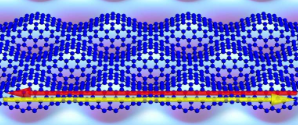Can monolayer graphene also achieve superconductivity? New technology promotes the development of quantum devices such as orbital magnets and superconductors
Xianji.com/xing xiuyan/2022-05-06 14:54:51 5018 0
Since graphene was first isolated and characterized in the early 2000s, researchers have been exploring ways to use this atomic thin nano material because of its unique properties such as high tensile strength and conductivity.
In recent years, twisted double-layer graphene made of two pieces of graphene twisted into a specific "magical" angle has been proved to be superconducting, which means that it can conduct electricity with a very small resistance. However, due to the low yield of manufacturing twisted bilayer graphene, manufacturing devices using this method is still challenging.
Now, a new study shows how patterning and periodic deformation of single-layer graphene can transform it into materials with the electronic properties previously seen in twisted graphene bilayers. The system also hosts additional unexpected and interesting conductive states at the boundary. By better understanding how monolithic graphene produces unique properties when subjected to periodic strain, this work has the potential to create quantum devices such as orbital magnets and superconductors in the future. The study, published in the Physical Review express, was conducted by graduate students V õ Ti ế n Phong and Eugene Mele of the Department of physics and astronomy at the school of Arts and Sciences at the University of Pennsylvania.
Depiction of a well-designed substrate that causes ripples in the deposited graphene sheet. This deformation produces a current that exists only on one side of the nanobelt structure. Source: V õ Ti ế n Phong
An alternative to the complex twisted bilayer method is to use a single layer of graphene, which is placed on a carefully designed substrate called a "nail bed", which applies external forces or strains in a periodic manner. In order to better understand the quantum geometry of this system, Mele and Phong set out to understand the theory of how electrons move in this single-layer system.
After computer simulation of the single-layer experiment, the researchers were surprised to find new evidence of unexpected phenomena along the material surface but only on one side.
"Generally, the overall topology is associated with the surface property, in which case all surfaces inherit the property," Mele said. "Here, the fact that there is an edge pattern on one side rather than the other side makes me feel very unusual."
This finding is unexpected because in this system, the average pseudo magnetic field generated when the system is strained is zero - one region is positive and the other is negative, which the researchers assume will offset any unique phenomenon.
"If the magnetic field is zero, you may not get any interesting physics," Phong said. "On the contrary, we found that even if the average magnetic field is zero, it still brings you some interesting edge physical phenomena."
To explain this unexpected result, Phong carefully studied a similar experimental system in which a single piece of graphene was bent to simulate a constant rather than a periodic strain induced field. Phong found that the system has the same topological index, which means that edge states that will only flourish on specific sides of the material will also appear.

"The physics here is similar and seems to be the correct explanation for the phenomenology we are studying," Phong said.
Overall, the study predicts that flat bands, similar to those found in twisted bilayer graphene, are produced by depositing an atomically thin monolayer onto a nail bed substrate that causes periodic deformation on the graphene sheet.
Researchers are already gaining a deeper understanding of these single-layer systems. One way for further research is to cooperate with assistant professor Bo Zhen to study the same phenomenon by using light waves. Researchers are also interested in understanding whether other unique properties present in twisted bilayer graphene may also appear in monolayer systems.
"Although physics is simple, which means you can make the system work in a more controllable way as you want, the phenomenology you can get from it is not. It is very rich, and we are still discovering new things, as we said," Phong said.
Moreover, because these single-layer systems are easier to use, this enhanced theoretical understanding may contribute to future discoveries in the field of edge state physics, including possible new devices, such as ultra small and incredibly fast quantum materials.
"Now we need to make great efforts to understand these twisted graphene bilayers. I think an interesting problem we want to solve here is the basic components of the physical system that can really do this," Mele said "We're building artificial structures that you can't build on interesting length scales from top to bottom - bigger than atoms and smaller than lithography - and if you can control it, you can do a lot of things."
This article is reproduced from https://www.hongyantu.com/news/29200.html , if there is infringement, please inform to delete






